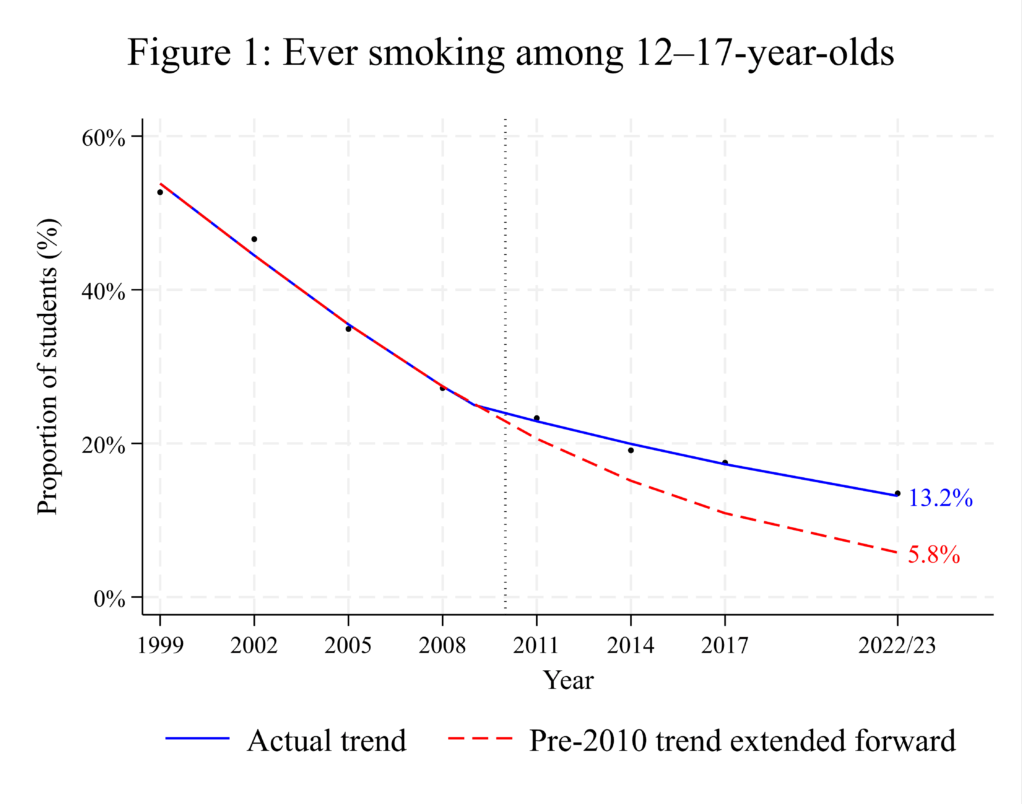In October last year, we published findings from our retrospective cohort analysis of data from the Generation Vape study in the Australian and New Zealand Journal of Public Health, accompanied by an InSight+ article. Our analysis examined the relationship between adolescent e-cigarette use (vaping) and subsequent cigarette smoking and was the first Australian study to do so using individual-level data. We found that adolescents aged 12–17 years who vaped were significantly more likely to subsequently initiate smoking, with the strongest increased risks observed among the youngest participants.
Despite our findings — and a large body of international cohort studies consistently reporting results similar to ours — some researchers question evidence from individual-level studies unless it is corroborated by changes in population-level smoking trends. For example, in a comment posted in the comment section of our previous InSight+ article, an Australian GP with a public profile in e-cigarette advocacy and research wrote:
“If vaping caused young people to smoke, we would expect to see increasing youth smoking rates. In fact, we are seeing the opposite. Youth smoking rates have been falling faster than anticipated since vaping became available.”
This claim caught our attention because, to the best of our knowledge, no Australian study had formally tested whether “youth smoking rates have been falling faster than anticipated since vaping became available”.

Our new research
Motivated by this gap in the evidence, we set out to analyse publicly available, population-level prevalence data from the Australian Secondary Students’ Alcohol and Drug (ASSAD) survey of students aged 12–17 years. Our findings, based on data from 172 406 students surveyed between 1999 and 2022/23, have been published today by the Medical Journal of Australia and are available for early view on the Wiley Online Library.
Before detailing our findings, it is important to explain what researchers might expect to see in terms of adolescent smoking rates “if vaping caused young people to smoke”. A common misconception — and one reflected in the GP’s claim above — is that “we would expect to see increasing youth smoking rates”. This is not the case. If vaping caused adolescents to smoke, we would not necessarily expect adolescent smoking rates to rise. Instead, what we might see is a slowing of historical declines — that is, smoking rates might continue to fall, but at a slower pace than before “vaping became available”.
With this in mind, we conducted several interrupted time series analyses looking for any changes in the rates of decline in smoking behaviours among 12–17-year-olds following the emergence of vaping in Australia. Specifically, we compared smoking trends from 1999 to 2009 — before e-cigarettes emerged in Australia — with those from 2010 to 2022/23, when vaping became available and increasingly common among adolescents.
Our findings
From 1999 to 2022/23, adolescent smoking rates declined considerably across all five smoking behaviours that we assessed (ever, past year, past month, past week, and daily smoking). However, the rates of decline in all five smoking behaviours slowed significantly from 2010 onwards, coinciding with the emergence and rise of vaping.
By 2022/23, about 13.2% of 12–17-year-olds had ever smoked (see Figure 1; “actual trend” estimate). However, this figure would have been only 5.8% had the ever smoking trend continued along the trajectory it was following before the emergence of vaping in 2010. Similar patterns were observed for past year smoking (9.7% v 4.3%), past month smoking (4.9% v 2.4%), past week smoking (3.1% v 1.5%) and daily smoking (0.9% v 0.2%) (data for daily smoking were only available for 14–15-year-olds).

What else might explain our findings?
As with any observational research, it’s important to consider other factors that could be influencing results.
First, while we used 2010 as the “change-year” when vaping began to emerge in Australia, it is reasonable to note that vaping wasn’t widespread at that time. Therefore, to check whether our choice of 2010 as the change-year might have affected our results, we also tested each possible change-year between 2008 and 2014. Our findings remained similar.
Second, it seems possible that changes in cigarette affordability for adolescents might explain slowing declines in smoking. After adjusting for affordability, however, the slowing remained. In fact, the adjustment improved our statistical models’ fit to the data, strengthening our confidence in our interpretation of results.
Conflicting findings in population-level studies
Not all population-level studies like ours have reported slowing declines in youth smoking following the emergence and/or rise of vaping. A 2018 US population-level study, for example, reported that smoking rates among US youth appeared to have accelerated in their decline from 2014 — the year that adolescent vaping began rising sharply in the US. The study, however, did not adjust for any potential confounders. In contrast, both our Australian population-level analysis and a recent similar analysis we conducted on New Zealand data found broadly similar levels of slowing in the declines of adolescent smoking from 2010 onwards — even after adjusting for cigarette affordability and price respectively.
Discrepancies between population-level studies highlight the limitations of relying solely on this type of data, which can be shaped by multiple influences on smoking. This is why it is important to draw on different types of evidence — and prospective cohort studies provide a crucial piece of the picture. These studies consistently show strong associations between adolescent vaping and future smoking, and are generally regarded as providing stronger evidence than population-level data. In this context, the alignment of our Australian and New Zealand population-level findings with those from cohort studies considerably bolsters the case that vaping might be contributing to smoking uptake among adolescents, particularly in Australia and New Zealand.
Conclusion
In new research published today, we found no evidence to support the claim that “youth smoking rates have been falling faster than anticipated since vaping became available”. On the contrary, our results clearly show that Australia’s progress in reducing adolescent smoking slowed from 2010 onwards — a shift that coincided with the emergence and rise of vaping.
Read the research in the Medical Journal of Australia.
Sam Egger is a senior biostatistician at the Daffodil Centre, a joint venture between the University of Sydney and Cancer Council NSW.
Professor Michael David is with the Daffodil Centre, a joint venture between the University of Sydney and Cancer Council NSW.
Ms Anita Dessaix is director of cancer prevention and advocacy at the Cancer Council NSW.
A/Prof Weber is a cancer epidemiologist in the School of Public Health at the University of Sydney. Her research program in lung cancer combines population-wide simulation modelling, clinical trials, and behavioural research to optimise lung cancer interventions such as tobacco control and screening.
A/Prof Qingwei Luo is an epidemiologist and health service researcher. Her research encompasses epidemiological studies, the investigation of health disparities, and the development of advanced statistical models to project future cancer burden.
Becky Freeman is a Professor of Public Health at the University of Sydney and has over 25 years of experience in the tobacco control field.
The statements or opinions expressed in this article reflect the views of the authors and do not necessarily represent the official policy of the AMA, the MJA or InSight+ unless so stated.
Subscribe to the free InSight+ weekly newsletter here. It is available to all readers, not just registered medical practitioners.
If you would like to submit an article for consideration, send a Word version to mjainsight-editor@ampco.com.au.

 more_vert
more_vert
This is excellent information and your team are to be commended for their work.